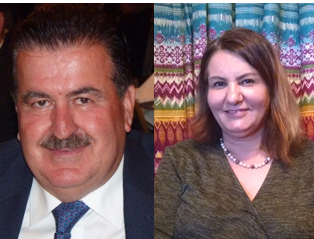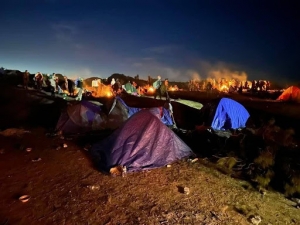By Jessica Brodkin Webb
January 7, 2025 (El Cajon) --In 13 days, President-elect Donald Trump could potentially begin to make good on his campaign promise to pursue mass deportations of immigrants and refugees living in the United States.
“As President I will immediately end the migrant invasion of America," Trump said in a Sept, 2024 speech and although he has not released specific details of how he might direct such a plan at a federal level, community leaders stand divided on how best to respond at the local level.
Under current California law, state and municipal governments are barred from working in conjunction with federal law enforcement agencies to actively pursue deportation for anyone who has not committed a serious crime. That approach stands in direct opposition to Trump’s proposed plan to conduct mass immigrant deportations.
El Cajon Mayor Bill Wells, in a letter to the Calif. Attorney General, says he plans to propose that his city fully cooperate with federal immigration authorities. San Diego’s Board of Supervisors majority, by contrast, has urged county authorities not to turn over any immigrants to federal authorities, while the County Sheriff has said she will take the middle ground and follow state law, cooperating only when immigrants have committed serious crimes.
Besides posing a challenge for local elected officials who must decide how they will answer to conflicting state and federal guidelines, an element of murkiness also exists for prominent community members and social service agency heads who spend many hours each week working directly with refugees.
 Photos by Miriam Raftery: Noori Barka and Dilkhwaz Ahmed, leaders of El Cajon nonprofits aiding immigrants and refugees, have contrasting views on deportations
Photos by Miriam Raftery: Noori Barka and Dilkhwaz Ahmed, leaders of El Cajon nonprofits aiding immigrants and refugees, have contrasting views on deportations
For example, Chaldean Community Council Founder Noori Barka said he doesn’t like to see people enter the country illegally and supports Trump’s plan to deport immigrants and refugees.
According to the Chaldean Community Council website, the social service organization provides “essential resources and support to help Chaldean and Middle Eastern families build a new life in El Cajon.” For individuals and families who have legally entered the country, they offer assistance with job placement, healthcare coordination, legal guidance and educational assistance among other things.
“I am against any illegal immigration and generally support people coming in the right way. Come like we all came, as immigrants, in a legal way. We have to do the right thing. Come with a degree, a relative, with refugee status.” Barka said.
He believes established members of East County’s Chaldean community, one of the largest in the nation, “came through the legal way” and with vetted backgrounds. Young people with “something to offer” are an asset, he said, including those who are able to enter the country legally with an H1 (work) visa.
However, Barka is concerned that recent waves of immigrants have not been subject to any background investigation and could bring danger to the community.
“People who are coming now, we don’t know their backgrounds and it's scary because sometimes we get criminals. We have to have the right to protect our borders and we have to have the right to allow people who want to come to the county to ask permission, but after we do a background investigation,” Barka said.
Meanwhile, License to Freedom Executive Director Dilkhwaz Ahmed who works daily with domestic violence survivors said some victims arrive undocumented and turning them back around after a harrowing journey to safety puts them at extreme risk. Niche populations such as these, she said, need special and individual consideration outside an all-encompassing policy.
“They’ve traveled thousands of miles to come to a safe country. Sending back those women and children, we put them at risk and what are we going to say: we can’t protect them? This population really needs us to support them, to give them a safe place, get them documents to start as a new human being,” Ahmed said.
Photo, left , a migrant encampment near Jacumba in San Diego County has drawn immigrants from around the world.
, a migrant encampment near Jacumba in San Diego County has drawn immigrants from around the world.
The legal process can take years, she explained, from connecting a newly arrived individual to an attorney, then helping them connect their situation with evidence of domestic violence.
“I have a client from Afghanistan, the Taliban killed her husband and it took her seven years to make it to the United States. She called me, scared she would be deported. Imagine what would happen if we send back this woman? What could happen to her? What is her destiny?” Ahmed asked.
The immigrant population she works with “came to the country for democracy, opportunity” and while License to Freedom doesn’t serve many undocumented individuals, there are some, Ahmed said. She wishes some of their cases could be reviewed from a different perspective.
Barka has a no-exceptions outlook on illegal immigration while Ahmed prefers to hear one’s story before deciding how to proceed, yet both rely on individual background information. In contrast, Trump’s plan— albeit lacking in granular details— emphasizes removing as many immigrants as possible regardless of their lived history—even DACA recipients or “Dreamers” brought to this country as children.
Photo, right, 2018 San Francisco rally for young immigrants brought here as children, Protected under DACA, they may now face deportation under the Trump administration
American Civil Liberties Union Executive Director Anthony Romero said, “President-elect Trump will soon have the full power of the U.S. government machinery at his disposal to target and displace immigrants at a scale our nation has never experienced,” prompting the question of where viewpoints like that of Barka, Ahmed or other leaders who parse individual stories from the larger immigrant invasion fit in with public policy.
In the end, Ahmed said, people need to find a sensible solution for immigration policy which she believes can only be attained when people with political differences are willing to sit through a calm conversation and find common ground.
“Deporting criminals? Yes. Why should they be here? But people who come to work and pay taxes, are good human beings and good citizens? We need to stop pointing fingers at each other, start to listen and come up with solutions. Both parties have to give some,” she concluded.
Source: SDG&E
January 6, 2025 (San Diego) – Due to extreme fire weather conditions and forecasted Santa Ana winds, San Diego Gas & Electric Company (SDG&E) has notified 64,866 customers that it may have to turn off power to reduce wildfire risk as early as Tuesday. Public Safety Power Shutoffs (PSPS) are approved by state regulators as an important safety tool of last resort to mitigate fire risk during dangerous weather conditions.
This week marks the driest start to the rainy season in San Diego County in 174 years. As a result of these dry conditions and expected Santa Ana winds, the National Weather Service has issued a Red Flag Warning for parts of Orange and San Diego Counties beginning Tuesday evening through late Wednesday night. SDG&E’s meteorology team is closely monitoring weather conditions.
Power shutoffs are possible in the following areas:
- Alpine
- Barona Reservation
- Boulevard
- Campo
- Campo Reservation
- Capitan Grande Reservation
- Chula Vista
- Descanso
- East San Juan Cap
- El Cajon
- Escondido
- Fallbrook
- Jacumba
- Jamul
- Julian
- La Jolla Reservation
- La Mesa
- La Posta Reservation
- Lakeside
- Los Coyotes Reservation
- Manzanita Reservation
- Mesa Grande Reservation
- Pala
- Pala Reservation
- Pauma and Yuima Reservation
- Pauma Valley
- Pechanga Reservation
- Poway
- Ramona
- Ranchita
- Rancho Bernardo
- Rancho Santa Fe
- Rincon Reservation
- San Diego
- San Pasqual Reservation
- Santa Ysabel
- Santa Ysabel Reservation
- Santee
- Sycuan Reservation
- Valley Center
- Viejas Reservation
- Warner Springs
SDG&E has activated its Emergency Operations Center and staffed it with key personnel to monitor weather conditions throughout the duration of the event, especially the wind speeds in the high fire risk areas of the county.
If SDG&E implements a PSPS for public safety, it will open Community Resource Centers to support impacted customers.
Given the potential for extended power outages, SDG&E encourages customers to be prepared. Outage preparedness tips can be found at sdge.com/outage-center; safety guidelines for generator use can be found at sdge.com/generator.
Never approach a downed line; report it by calling 911 or SGD&E’s call center at 800-411-7343.
Real-time information about unplanned power outages can be found at www.sdge.com/outage.
Updates about this PSPS can be found at sdge.com/Ready and SDGEToday.com or by following SDG&E’s X channel, @SDGE.
